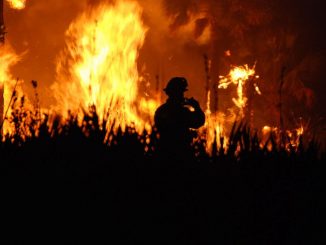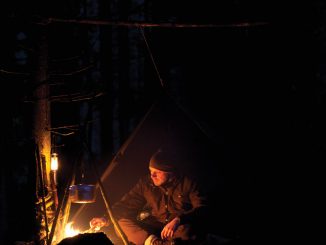
16 Essential Tips for Securing Potable Water
Editor’s Note: This is one of three sections about water we published on our Fall 2018 Prepper Manual. The other two sections are The Lubricant of Life and H2O Tools.
Water is one of the most important elements of any survival plan. While hydrating your body is a priority, water is also needed to prepare many of the foods we often stockpile for emergencies, such as freeze-dried meals. We also use it to keep much of our gear and ourselves clean; and while this might not be a survival priority, it sure makes life suck just a little less.
It can be helpful to understand how important water is to us by really taking a close look at how often it impacts our lives for just one day. Here are some tips on finding, filtering and storing water.
1.0 OUTSIDE SOURCES
1.1 Natural Bodies of Water
Running water rarely freezes, so look to rivers, creeks and streams first. If you know of any natural springs in the area, hit those up as well. However, Be very careful about chipping a hole in lake ice. Stick close to shore, just in case the ice cracks and dumps you in. It is advisable to work in pairs so one person can assist the other if they get into trouble.
1.2 Snow and Ice
Ice is preferable to snow when it comes to melting it for water. As a general rule of thumb, 13 inches of snow is equivalent to 1 inch of rain. This is because there is actually a lot of air in snow. Ice is far denser than snow, and thus, it gives you much more “bang for your buck,” so to speak. Bear in mind that just because the water is frozen doesn’t mean it is potable once thawed. All raw water should be considered contaminated and disinfected before consumption.
1.3 Rain
If it rains, you can collect rainwater using containers placed on the ground. However, a rainwater catchment system with gutters and barrels is far more efficient. In a pinch, you can even use a sponge to soak up water from puddles and squeeze it into a bucket. While rain is generally pure as it falls, it will become contaminated by whatever could be in the air and the surface it lands on. Filter or disinfect this water before drinking it or using it for food prep.
2.0 INSIDE SOURCES
2.1 Bathtub
If you learn of, or suspect, an impending water shortage, fill your bathtub. You can buy products that are essentially large plastic bags that fit into the tub, which you can then fill. Lacking a WaterBOB or similar product, just plug the drain and fill the tub to the top. If you aren’t using a commercial product designed for this purpose, you’ll want to filter the water before consuming it. (Think about it: Just how clean is your bathtub on average?)
2.2 Water Heater
Your water heater contains at least 20 to 50 gallons of water, even if it isn’t running due to a power or gas outage. If you decide to drain the water in an electric water heater, be sure to flip the switch at the breaker box so the heater doesn’t come back on when the power is restored. Otherwise, the heating element inside the water heater could be damaged if it powers on without water inside.
2.3 Pipes
There might be water sitting in the pipes of your home. Drain them by opening the faucets at the highest and lowest points of the house, keeping a bucket or other container at the latter location. It might not be much, but every little bit helps. This could also prevent your pipes from freezing and bursting if your house is not being heated.
3.0 DISINFECTION
3.1 Pre-filtering
Any disinfection method works better on water that has had most or all of the debris, dirt and other suspended particles removed. Pour the water through a coffee filter, bandana, T-shirt or other similar material to remove the larger contaminants. Once the water is less “chewy,” the disinfection process works faster and more efficiently. Plus, if you’re using any sort of water filtration equipment, the filter will last longer by not having to remove as much debris.
3.2 Bleach
Common, unscented household bleach can be used to disinfect water and make it safe to drink. If the water is clear, add 1/8 teaspoon of bleach per gallon of water. If the water is cloudy, double it to 1/4 teaspoon of bleach. Stir or shake it up well and then let the water sit, uncovered, for 30 minutes. There should still be a slight chlorine odor. If there isn’t, add the same amount of bleach, swish it around again and wait another 15 minutes.
3.3 Water Pasteurization Indicator
A water pasteurization indicator, or WAPI, is a simple thermometer that can tell you when the water has reached the temperature necessary to kill nasty microbes. Bringing water to a rolling boil isn’t technically necessary. Water boils at 212 degrees (F), and microbes are killed in under one minute at 158 degrees. A WAPI can conserve energy, as well as shorten the time to disinfect water.
3.4 Water Filters
Good brand names for water filters include Sawyer, Berkey, Katadyn and MSR, among others. Pay attention to the filter capacity when buying your units and replacement filters. You don’t want something that will only last a short time, simply because you have no idea how long you’ll need to rely upon the filter for your drinking water. Additionally, read the package and research online to ensure the filter you’re considering will remove all the pathogens and other nasty critters that are concerning to you. Not all filters are equal in all areas, and there are plenty that don’t address chemicals and heavy metals.
3.5 Water Purification Tablets
Chlorine dioxide tablets work well on all waterborne pathogens, including bacteria, viruses and protozoa. Plus, they tend to improve the taste of the water a bit. River water will still taste like river water, just a little less so.
4.0 STORAGE
4.1 Bottled Water
Storing cases of bottled water is one of the easiest and least expensive ways to keep water for emergencies. One case of 24 half-liter bottles equals a little more than 3 gallons, which is sufficient for one person for a couple of days, if they’re careful. Stack the cases with the caps up, but not too high, lest they tip. Keep them off concrete floors by using wooden pallets or something similar. This will prevent the possibility of chemicals in the concrete from leaching into the water.

Unscented bleach can be used to disinfect questionable water. Just add 1/8 teaspoon if the water is clear or 1/4 teaspoon if it is cloudy, stir and wait 30 minutes.

A tank-style water heater holds tens of gallons of water that can be drained and used as needed, even if the power is out.
4.2 Recycled Bottles
Soda or juice bottles can be carefully washed, rinsed and filled with tap water to save for later. Water from a municipal source that uses chlorine treatment is good to go into these containers. Otherwise, add a couple of drops of unscented chlorine bleach. Seal the bottles tightly and label them with the date they were filled. Keep them in a cool, dry, dark location. Rotate the supply every six months, using the old water for houseplants, gardens and pets.

Fill your bathtub with water if you feel an emergency is on the horizon. However, no matter how clean you think the tub is, disinfect the water before drinking.

When filling your bathtub with water for an emergency, use the cold tap only. This way, you won’t drain your water heater. As a result, you will have that as a backup source of water.
4.3 Avoid “Creative” Solutions
Storing water is not the time to get creative or inventive with containers. If it wasn’t created to store water, soda or juice, take a pass. Don’t use milk jugs, bleach bottles or cat litter buckets. Some folks have taken to storing water in canning jars. While there’s nothing unsafe about doing it, the glass jars are obviously fragile and heavy. Plus, each jar holds only a small amount of water.
RUNNING WATER RARELY FREEZES, SO LOOK TO RIVERS, CREEKS AND STREAMS FIRST. IF YOU KNOW OF ANY NATURAL SPRINGS IN THE AREA, HIT THOSE UP AS WELL.

Collecting water from rivers and streams is a great option, but, as with any raw water, make sure you disinfect it before drinking. Moving water can still have waterborne pathogens swimming around in it.

Ice is denser than snow. Thus, it will yield more water when melted. But be careful and stick close to shore when harvesting it.
4.4 Rotation
Water doesn’t deteriorate or rot, but any stored water that hasn’t been commercially bottled should be used up and replaced after six months. A good reminder is when you change your clocks for Daylight Savings Time. Use the water for gardens, houseplants, birdbaths and cleaning, rather than just dumping it down the drain.

Snow can be collected, melted and filtered for potable water, but you might be surprised at how much snow it takes to amount to a decent drink.

Puddles can be sources of water—but consider them a last resort due to potential contamination from pollutants on the pavement.
4.5 Water is Heavy!
Make sure the floor on which your water is stored can handle the weight. A few cases of bottled water is one thing; a few 55-gallon barrels is quite another. Never store water in plastic containers directly on concrete, though. Use wooden pallets or something similar as a buffer to prevent chemicals from leaching into the water from the concrete.
Editor’s note: A version of this article first appeared in the Fall 2018 Prepper Manual print issue of American Survival Guide.





Be the first to comment